Inside production designer John Iacovelli’s Atwater Village home
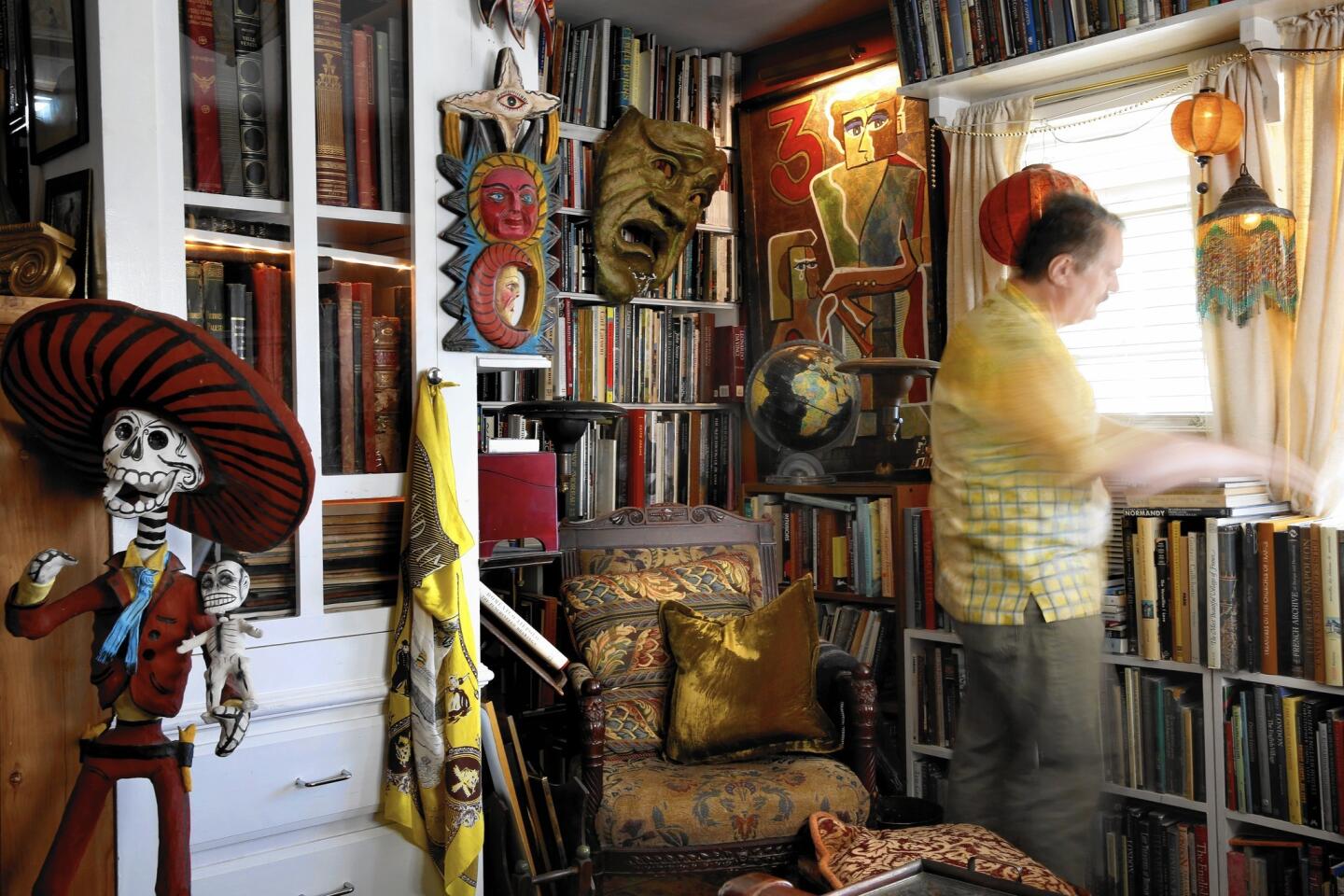
John Iacovelli’s library, formerly the living room of a second unit built in 1959, is filled with art and architecture books. (Liz O. Baylen / Los Angeles Times)

John Iacovelli’s Venetian-style house was a fantasy bungalow built in 1927 by real estate developer Barney B. Kenoffel who, inspired by silent film sets, created 18 homes in a variety of ancient architectural styles on Brunswick Avenue in Atwater Village. The designer painted the stucco exterior in Benjamin Moore Sweet Pea pink.
(Liz O. Baylen / Los Angeles Times)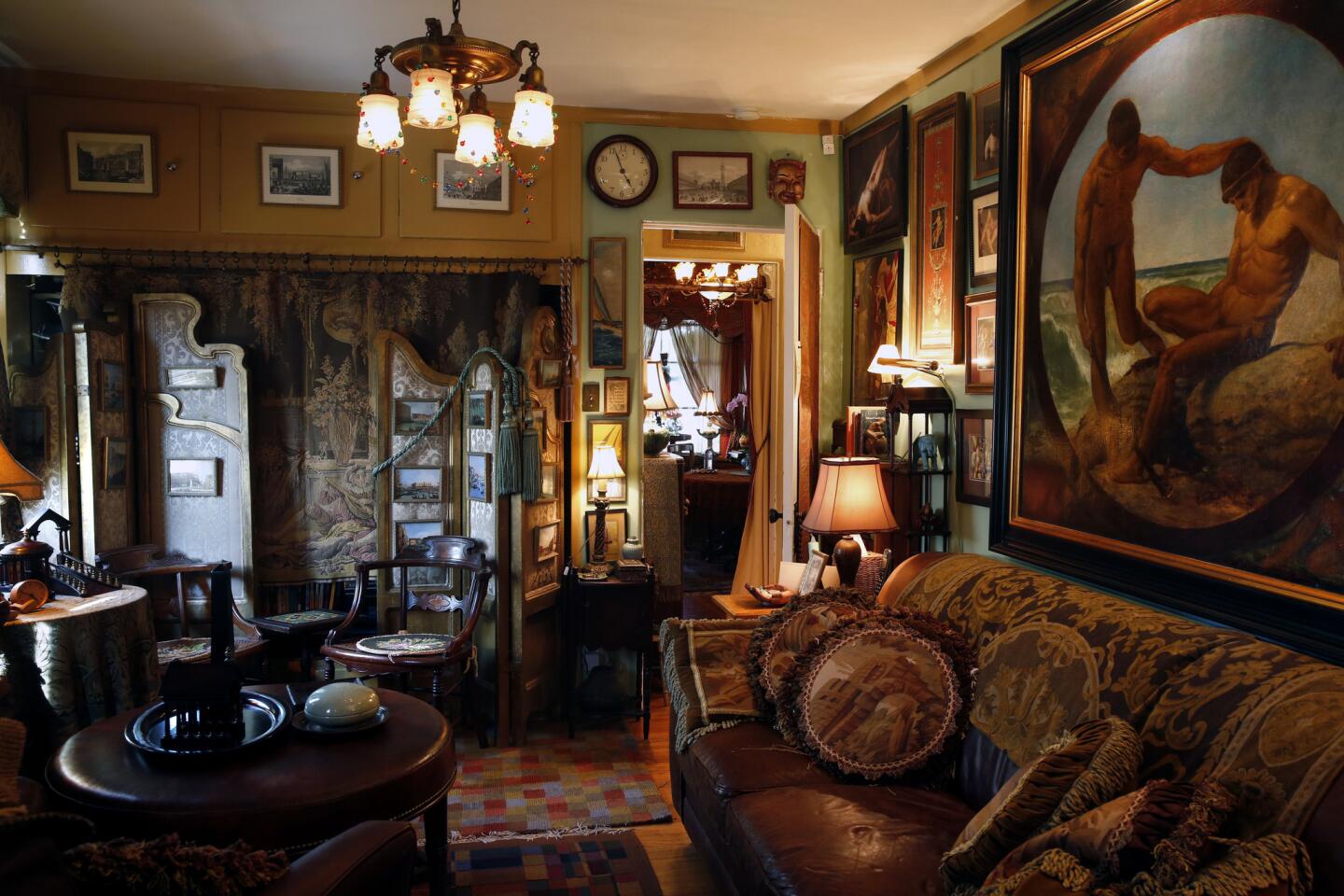
Iacovelli’s sitting room was originally one of the two bedrooms in the main house. The leather sofa is from Macy’s Home Store with Belgian tapestries and pillows, and there is a carved Italian hall bench and dressing screens designed for a production of “Dangerous Liaisons.” “The vibe to me is like an English gentleman’s room,” says the designer.
(Liz O. Baylen / Los Angeles Times)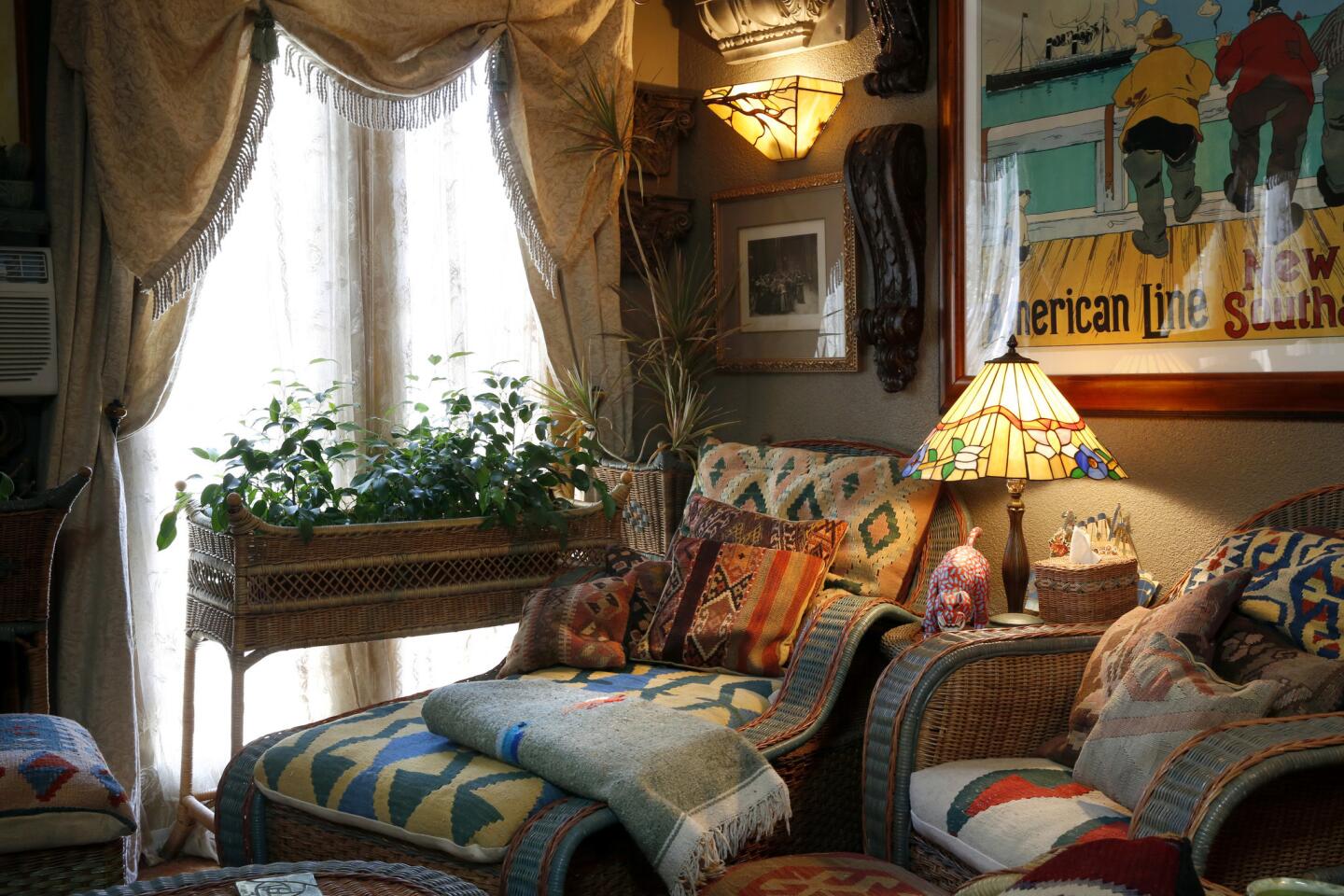
Between the guest room and his library, Iacovelli created a reading room. “This room was formerly the porch to the back unit and just last year I enclosed it,” he says. Mid-1980s wicker from Macy’s, the first furniture he bought in L.A., is enlivened with Southwestern textiles and kilim cushions.
(Liz O. Baylen / Los Angeles Times)Advertisement
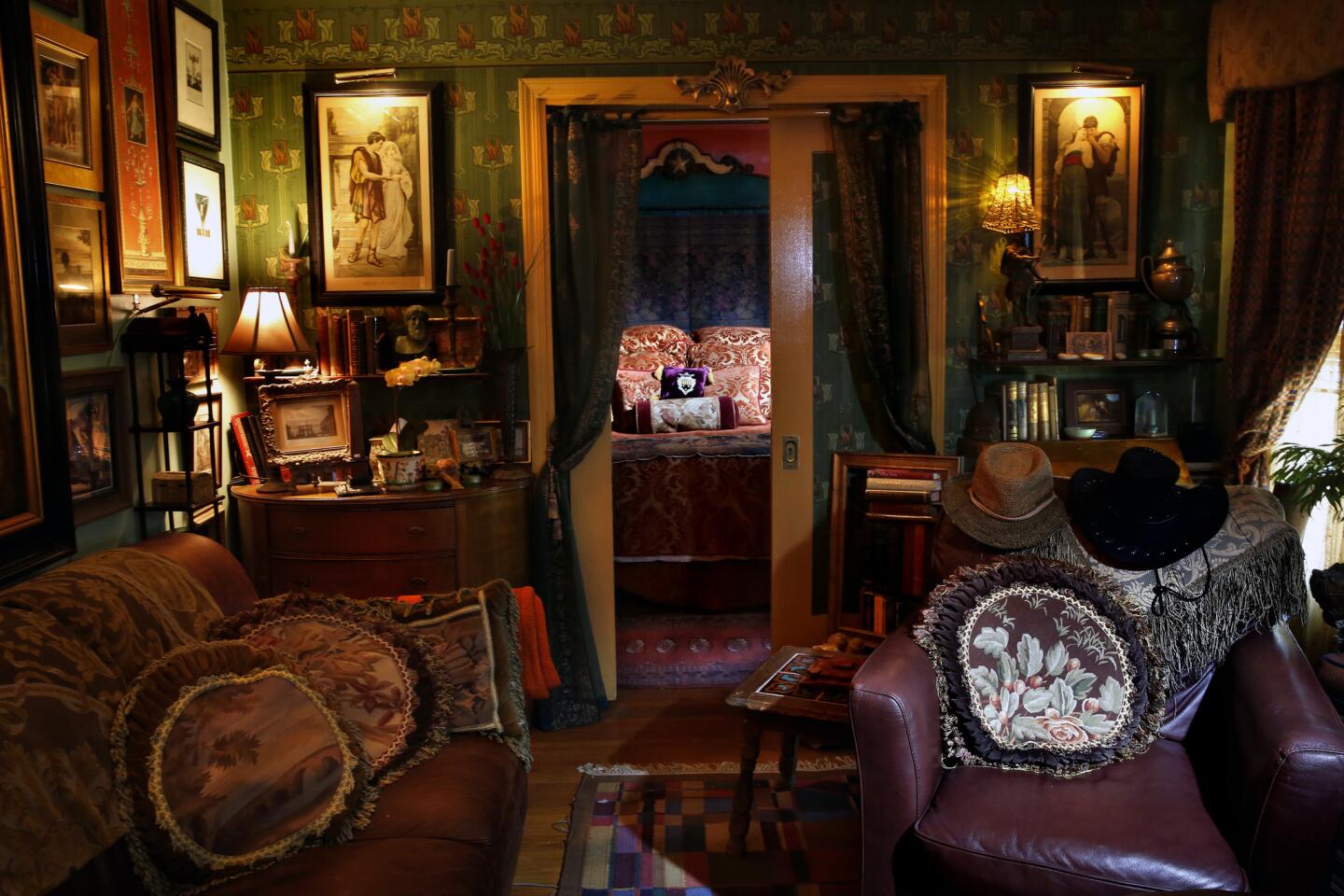
The wallpaper in the sitting room, a 1909 Bradbury & Bradbury print called Forrest Green Burnaby, was used in “The Importance of Being Earnest” at the Pasadena Playhouse. Beyond the sliding pocket doors is the master boudoir.
(Liz O. Baylen / Los Angeles Times)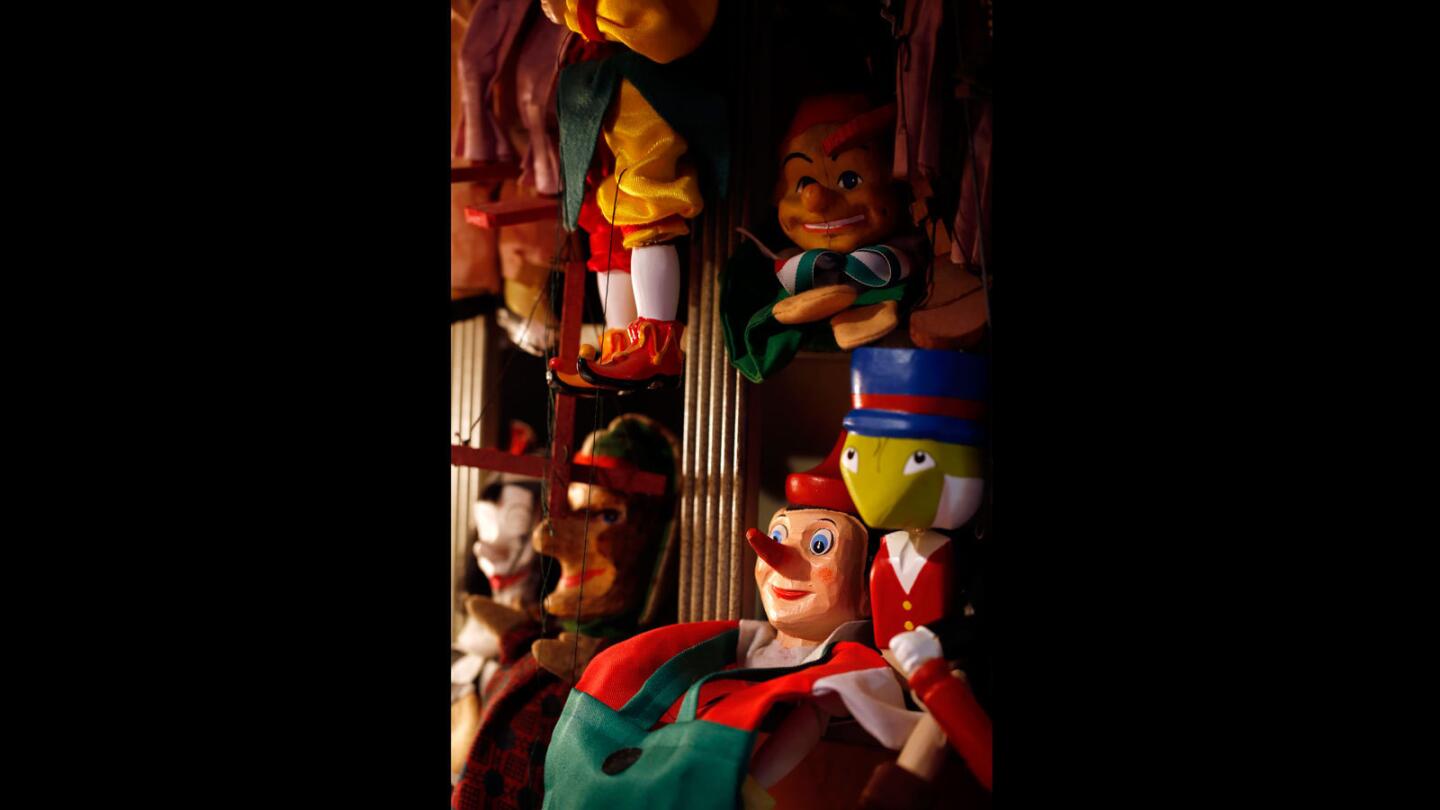
Carved Mexican marionettes of Pinocchio and Jiminy Cricket are part of Iacovelli’s trove of international puppets kept in a cabinet in his bedroom. “I have collected them since I was a small boy when the first set I designed was for the puppet theater my artist father built for me,” he says.
(Liz O. Baylen / Los Angeles Times)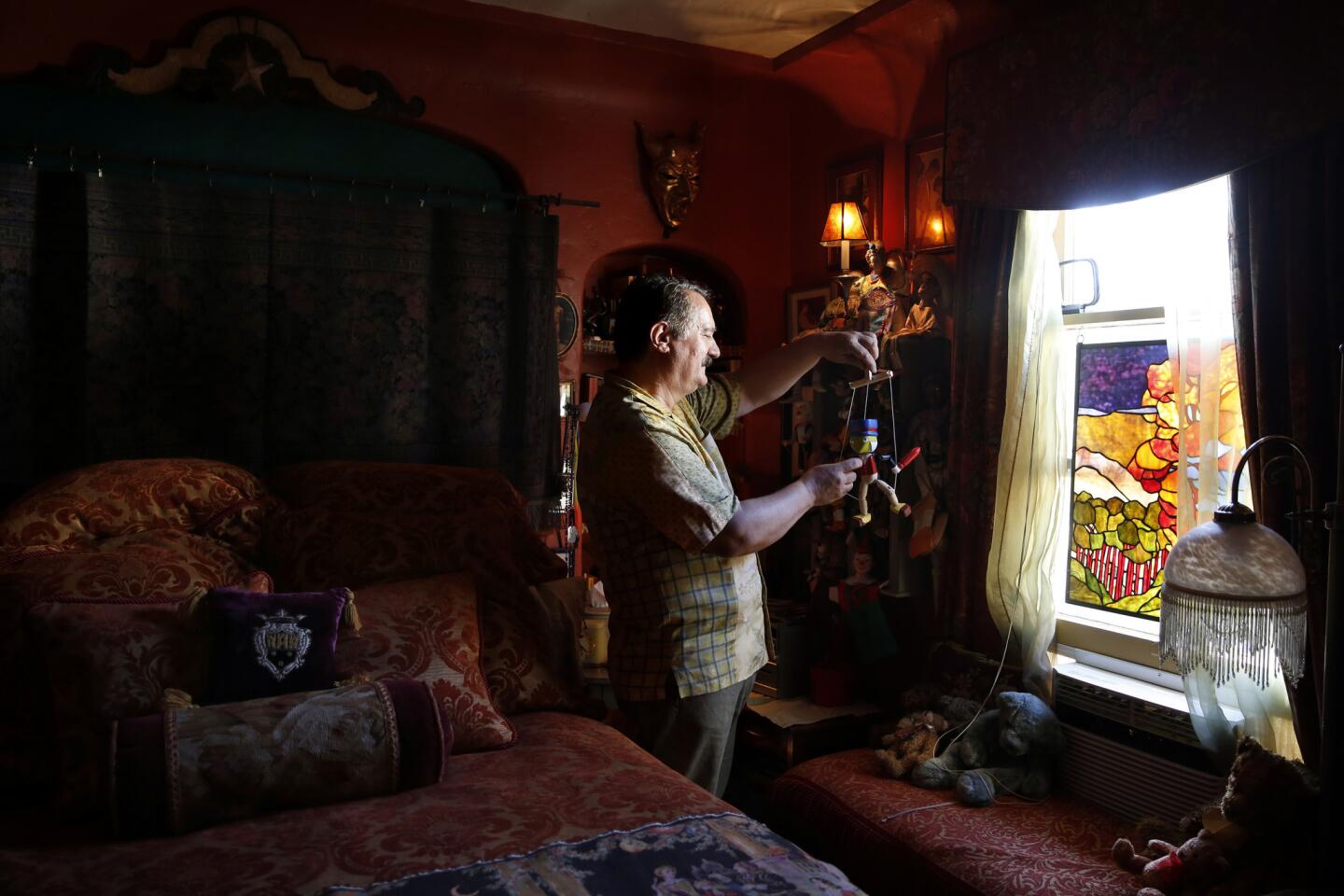
The master bedroom is painted with Benjamin Moore Fire Dance. The bedding is Chenille Damask from Michael Levine in downtown Los Angeles. An antique French floral tapestry serves as a kind of headboard and, Iacovelli says, “hides a risque painting.” The stained glass panel was purchased at a Pasadena Playhouse prop room sale.
(Liz O. Baylen / Los Angeles Times)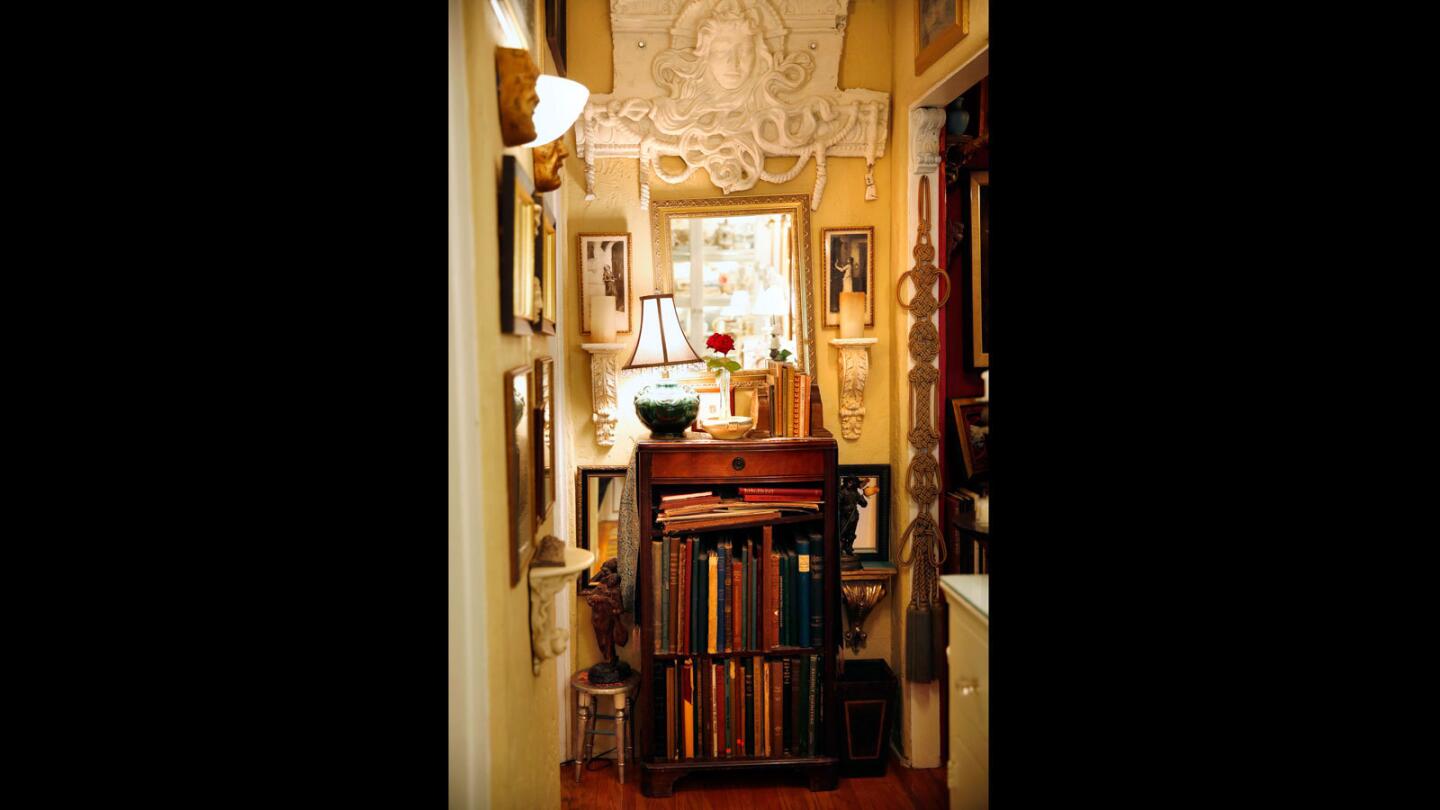
In the hallway to the guest room and bath, Iacovelli mixed an Art Nouveau cornice piece from a Jane Fonda film with 19th century etchings and a Chinese rope piece he bought at the Rose Bowl Flea Market.
(Liz O. Baylen / Los Angeles Times)Advertisement
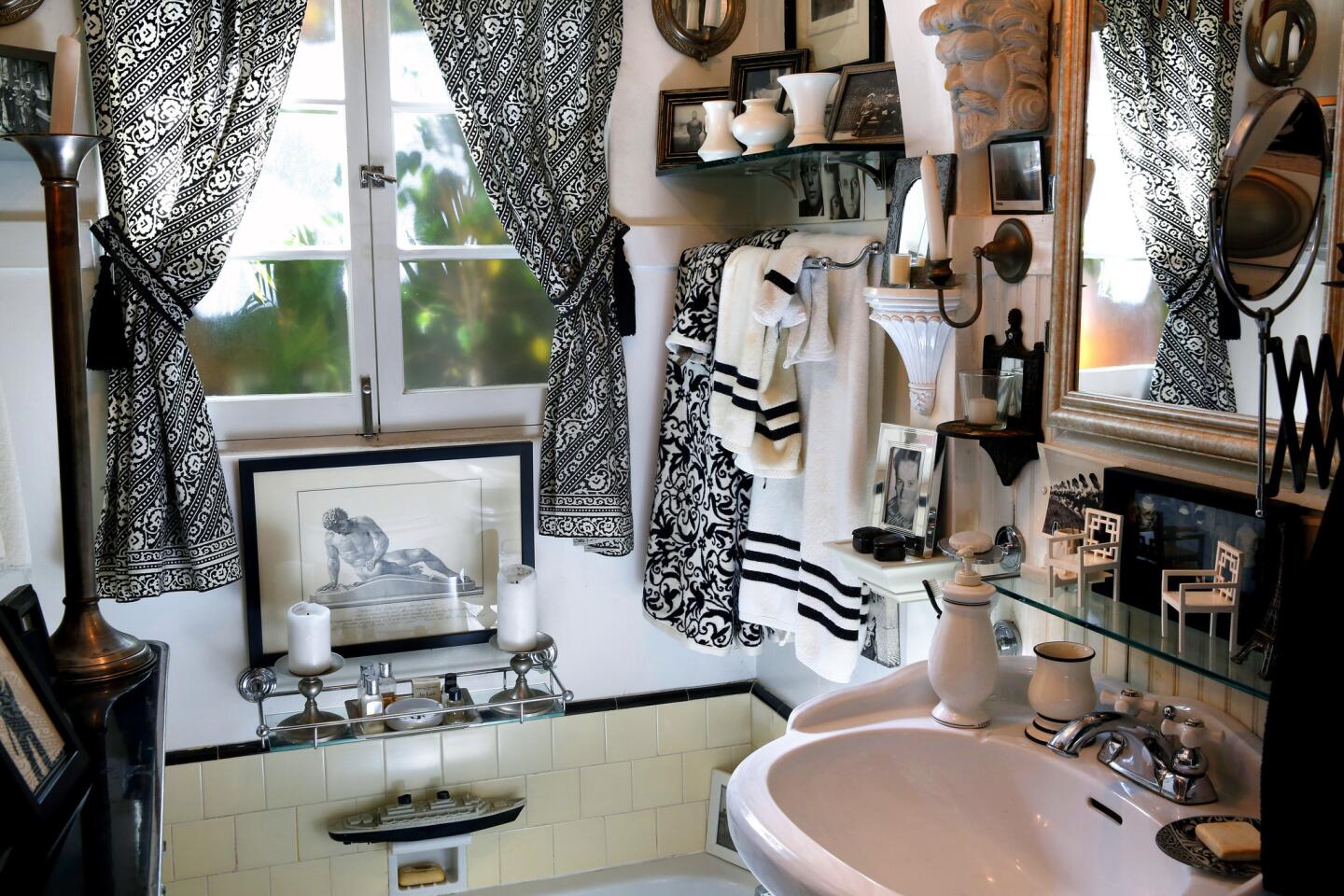
Not every element of the bathroom is vintage. The fabric used on the windows is a black and white print from Ikea and the sink is a contemporary Home Depot model with old-fashioned styling.
(Liz O. Baylen / Los Angeles Times)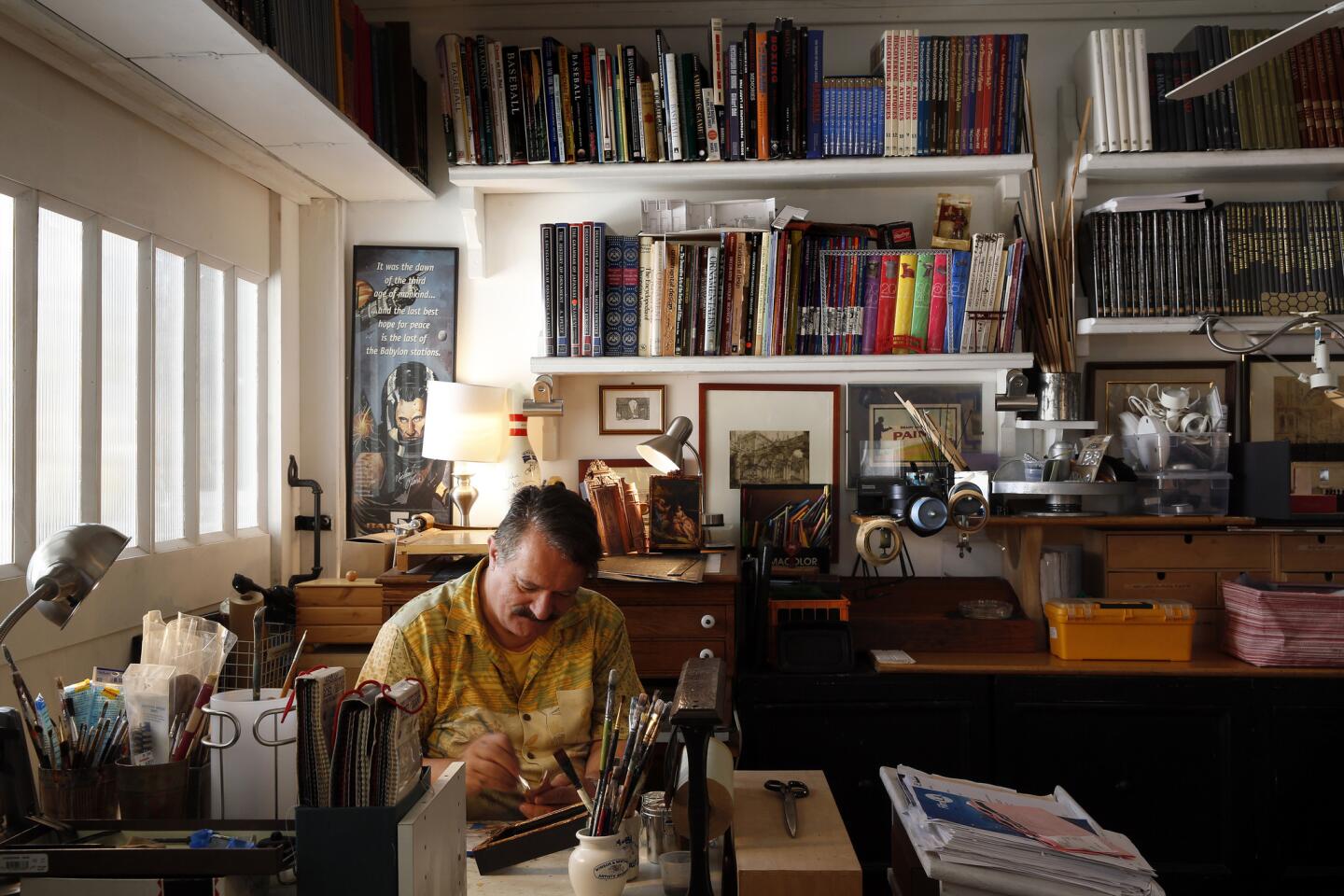
“I re-purposed a window from the main house so I could get northern light,” Iacovelli says of his studio, where he has two drafting tables, a computer workstation, a central table for meetings and model building and a table for painting.
(Liz O. Baylen / Los Angeles Times)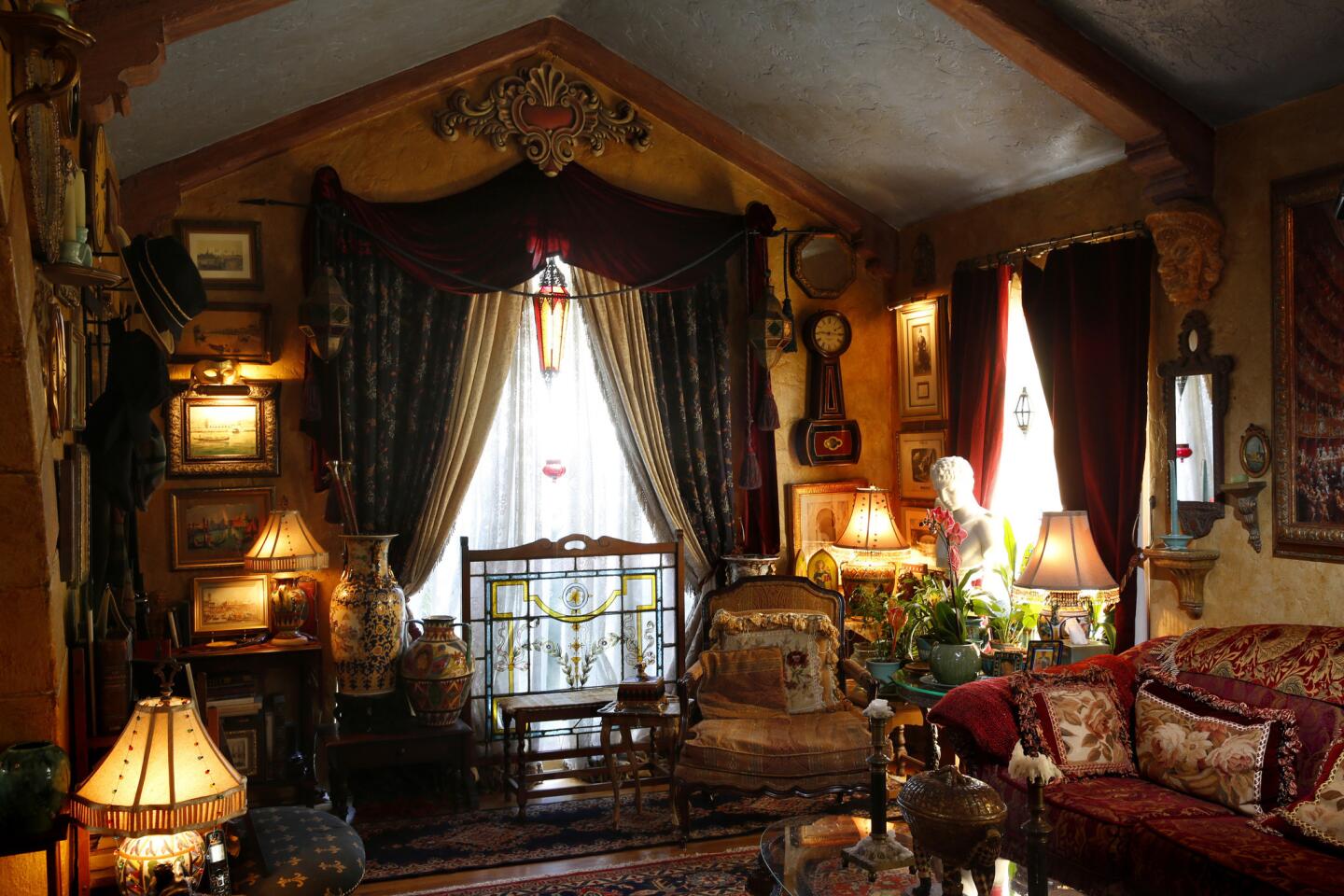
Iacovelli used theatrical glazing techniques to give depth and age to living room walls in Palace White and ceilings in Marlboro blue by Benjamin Moore. The window treatment is lace, blue damask and red curtains from various stage productions. On the wall, paintings of Venice and an antique banjo clock. “I got the Victorian glass fire screen at the American Cancer Society thrift store in Toluca Lake for $100,” he says.
(Liz O. Baylen / Los Angeles Times)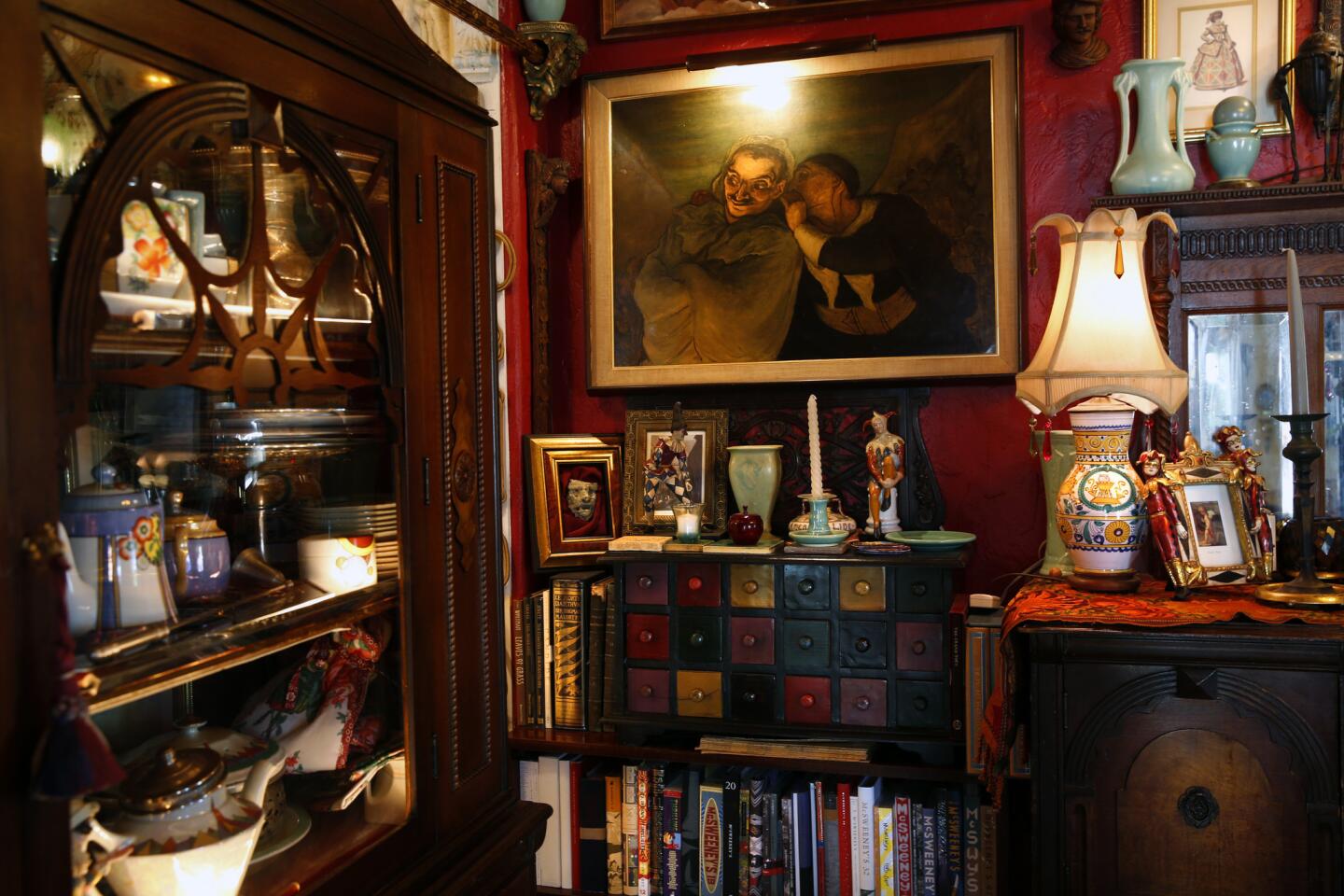
The dining room walls are painted in a traditional glossy oxblood (Pratt & Lambert Red Velvet). Iacovelli applied gold leaf to the ceiling by hand. The hutch contains Iacovelli’s parents’ collection of Hall Deco pottery and bone china from occupied Japan. The matching sideboard, he says, is “the kind you would get in the Sears catalog in the early part of the 20th century.”
(Liz O. Baylen / Los Angeles Times)Advertisement
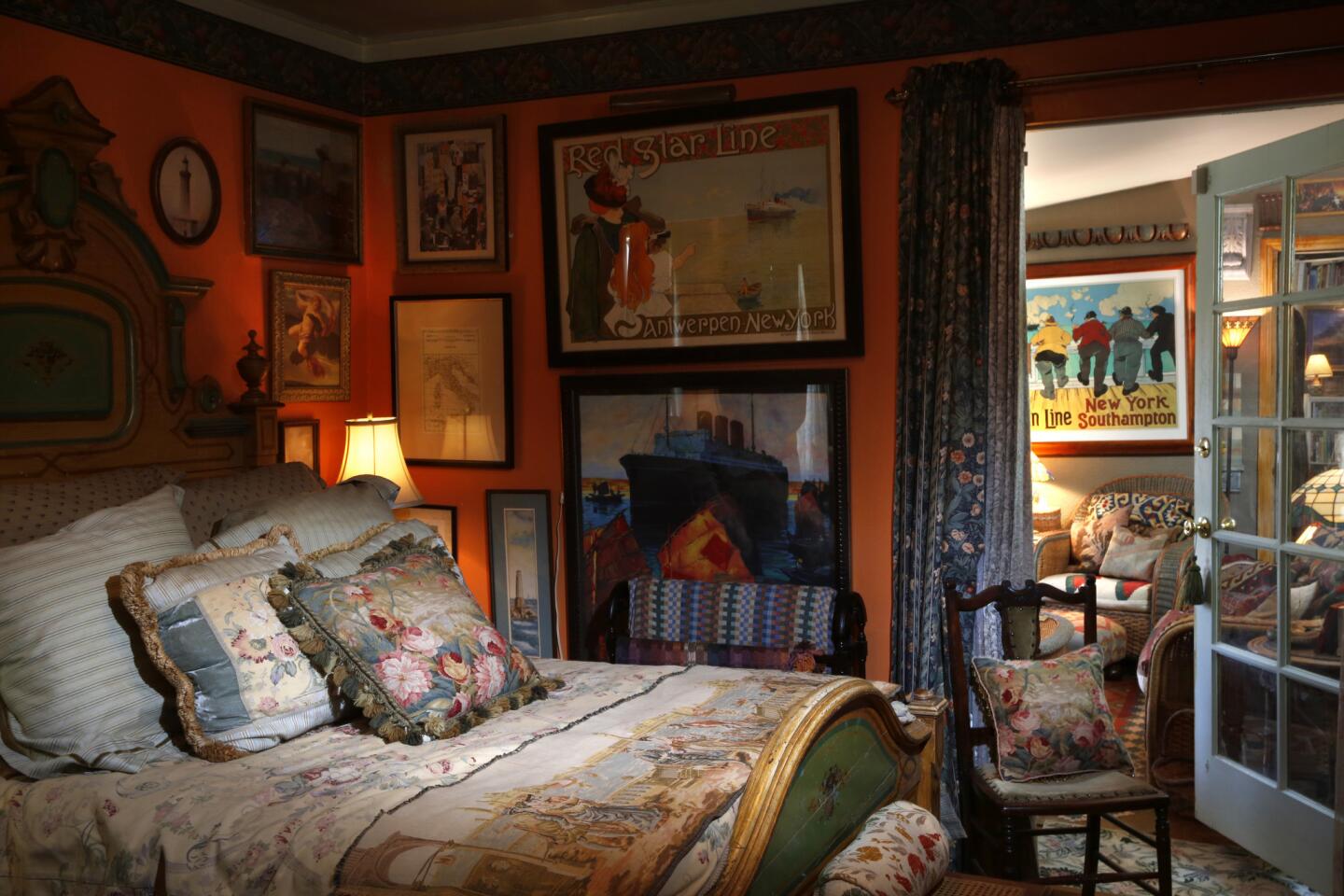
The guest room is painted with Benjamin Moore Calypso Orange. The Victorian carpenter-style painted bed is a family heirloom dating back to the 1870s and part of a four-piece suite including commode with drawers and doors and a mirrored bureau. The floral pillows and bedspread are Waverly and the chair was purchased at the Long Beach flea market.
(Liz O. Baylen / Los Angeles Times)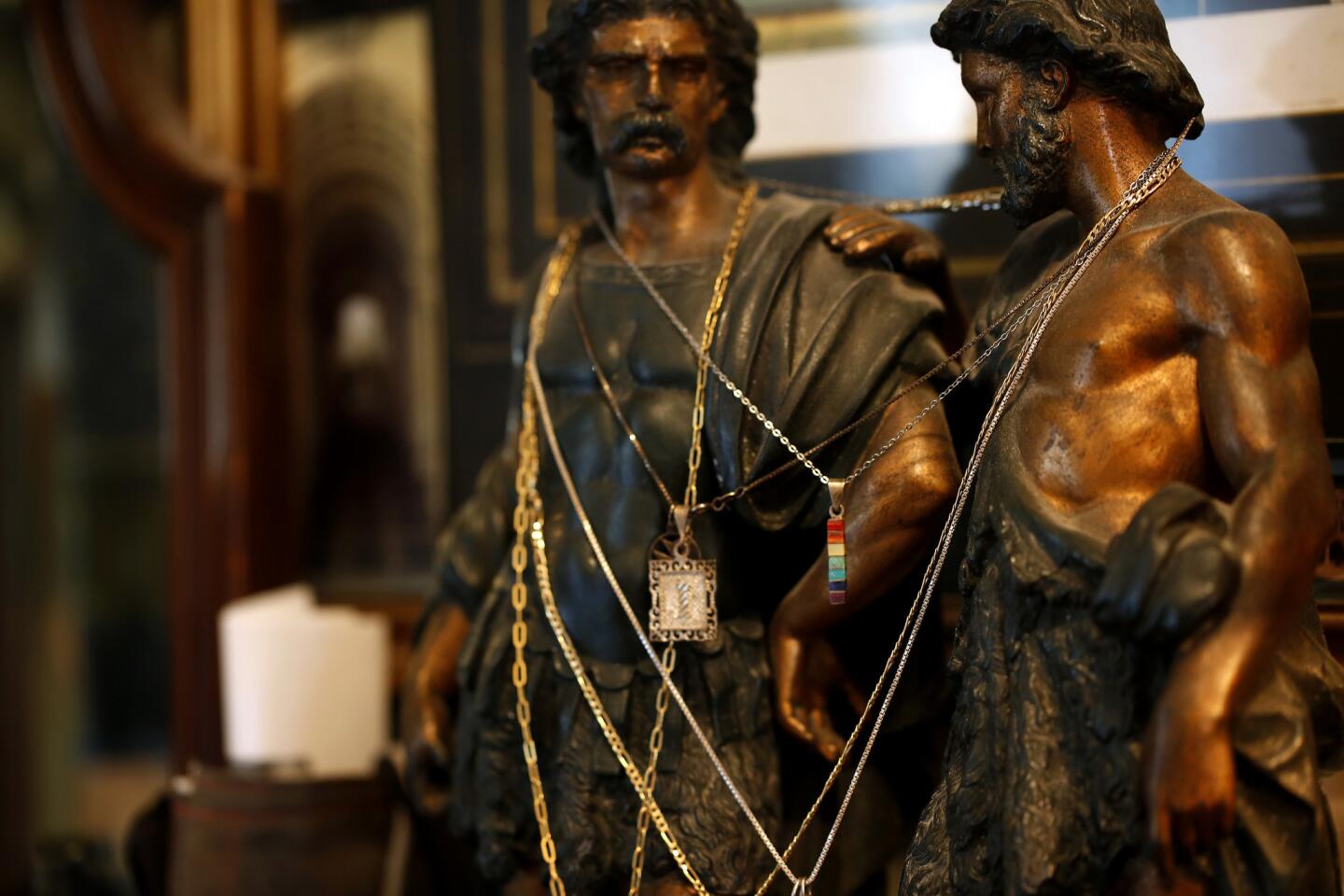
The Emmy Award-winning production designer John Iacovelli has filled his 1927 Atwater Village home with furnishings and memorabilia from his decades-long career.
(Liz O. Baylen / Los Angeles Times)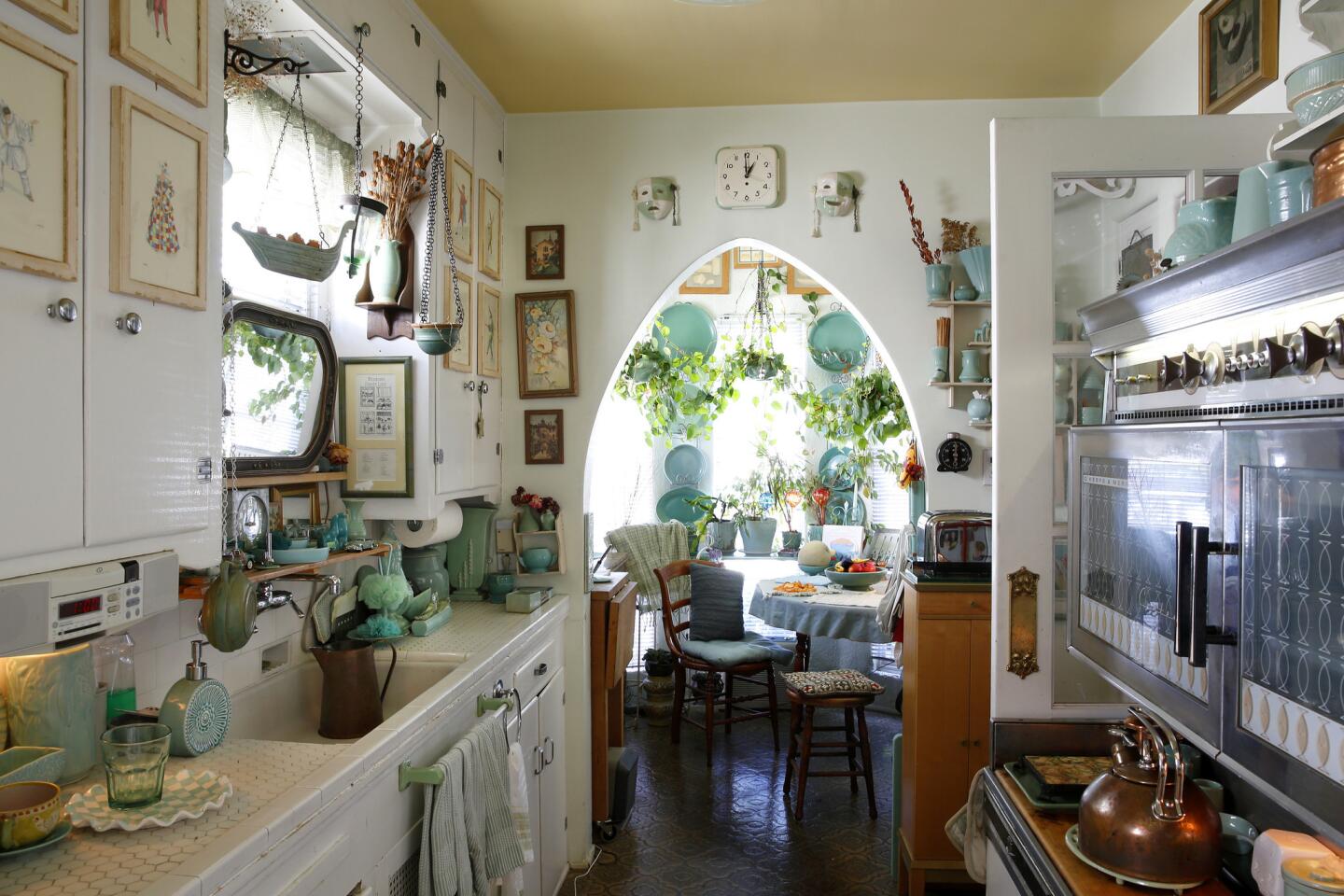
To gussy up white gloss cabinets, Iacovelli screwed framed Commedia dell’arte watercolor prints from Venice, Italy, to the doors. The hexagonal tile countertops date to 1928. “The aesthetic and practical advantages make me love the kitchen even more and they are incredibly durable,” he says.
(Liz O. Baylen / Los Angeles Times)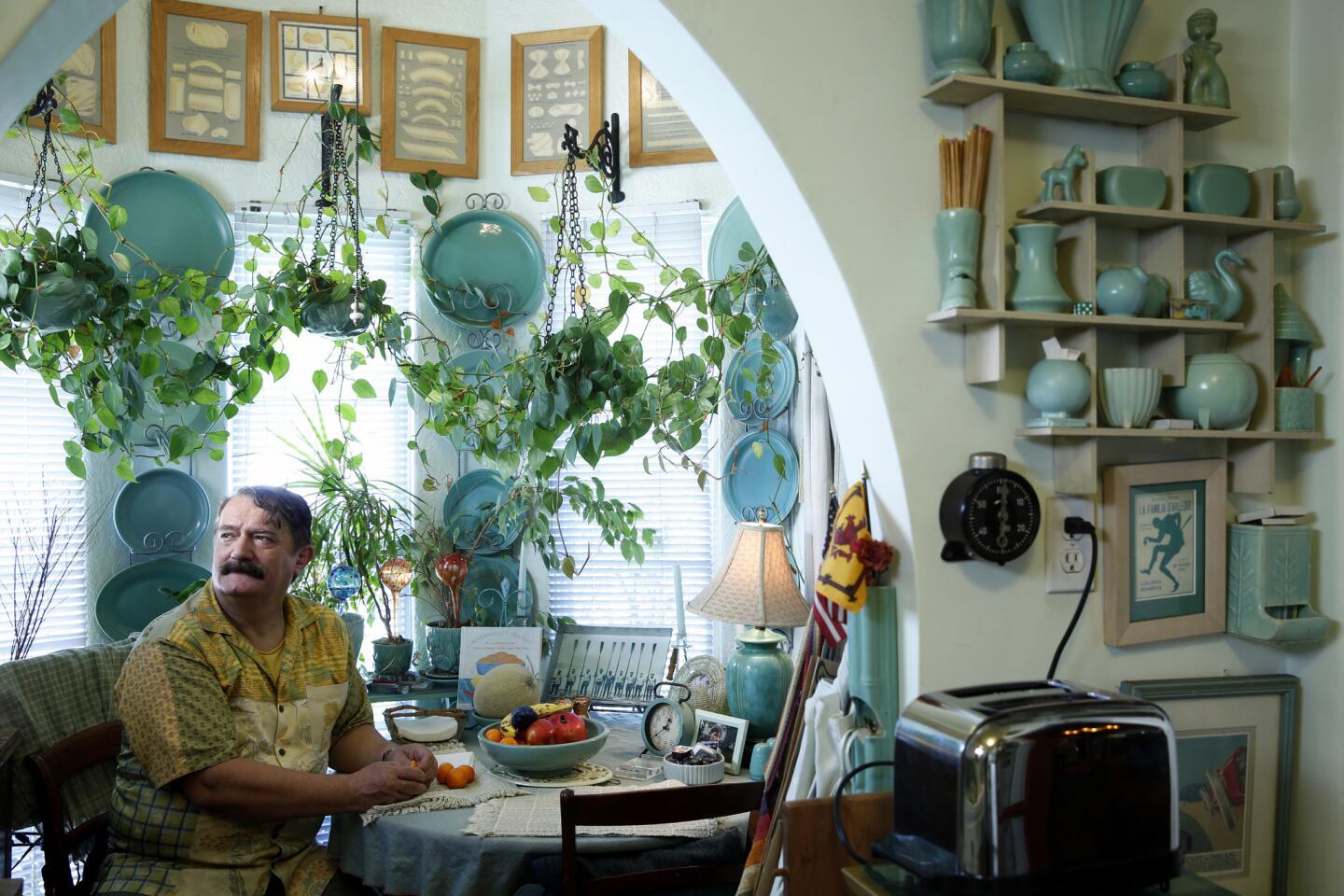
The breakfast nook walls, painted with Benjamin Moore Italian Ice Cream, are covered in framed pages from Italian pasta catalogs and classic California pottery serving platters. Iacovelli sits in an English Victorian side chair at a maple 1930s American kitchen table.
(Liz O. Baylen / Los Angeles Times)Advertisement
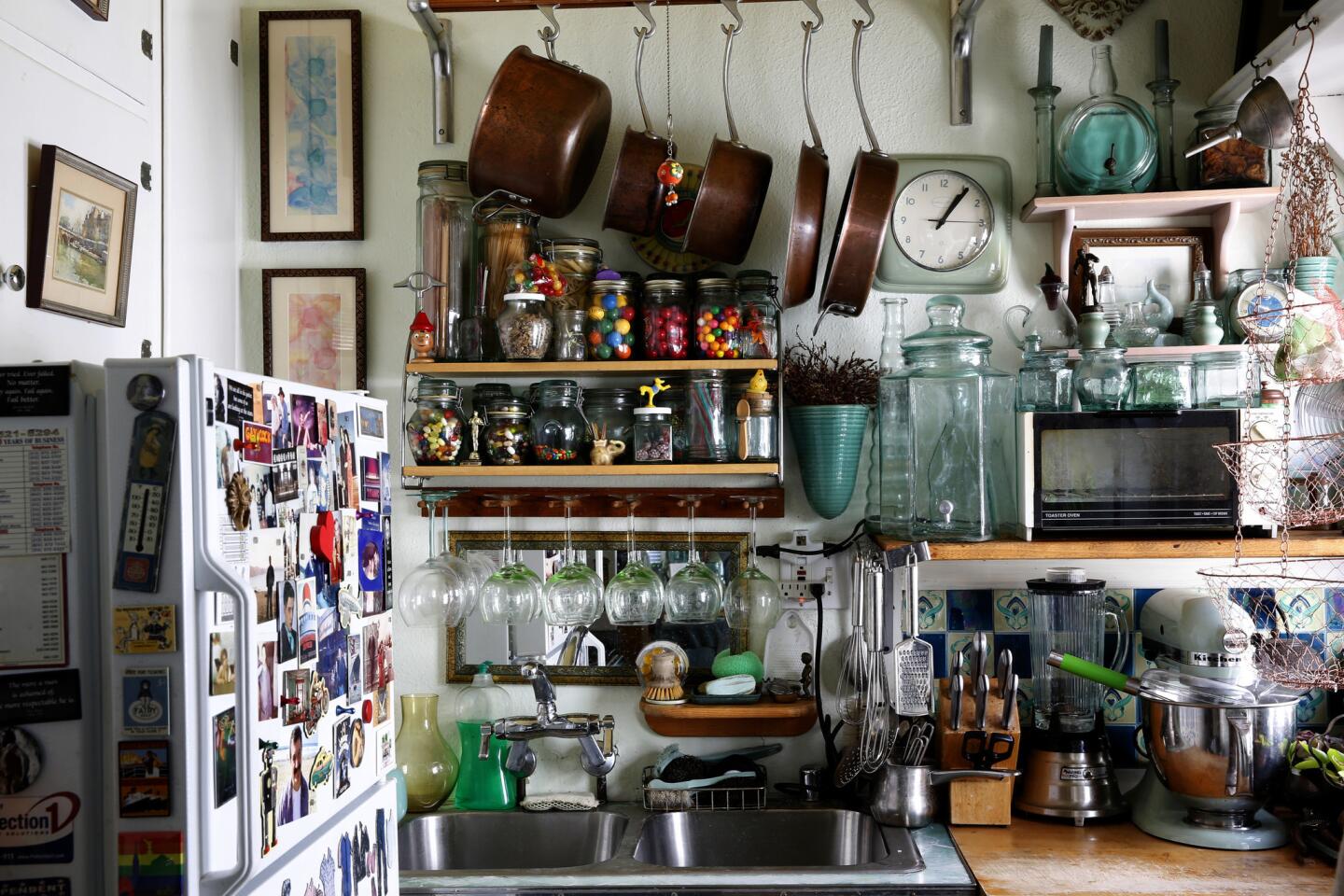
“Living in New York taught me how to do this kitchen, says Iacovelli, who studied his craft at the Tisch School of the Arts in Manhattan. “Everything is in arms’ reach. I only have a few appliances out but they have to be gorgeous: a Hamilton Beach blender, a mix-master and an elegant Hamilton Beach toaster.”
(Liz O. Baylen / Los Angeles Times)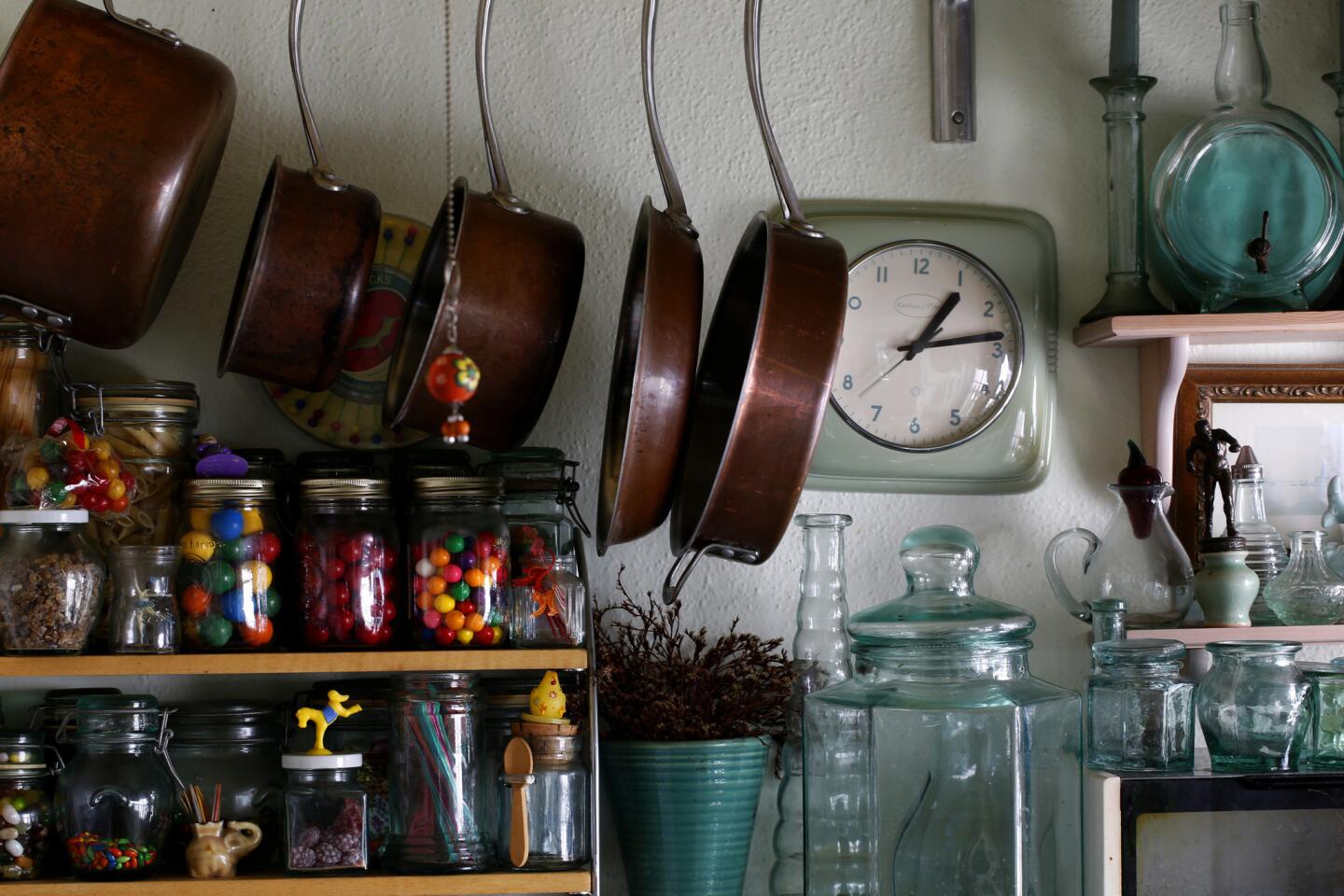
“These are serious copper Calphalon pots and pans I got in Macy’s in New York when I was designing a prime-time series for NBC,” says Iacovelli. “I gave up trying to polish them; I love the work-aged patina even more.” The clock is a vintage reproduction from Pier One.
(Liz O. Baylen / Los Angeles Times)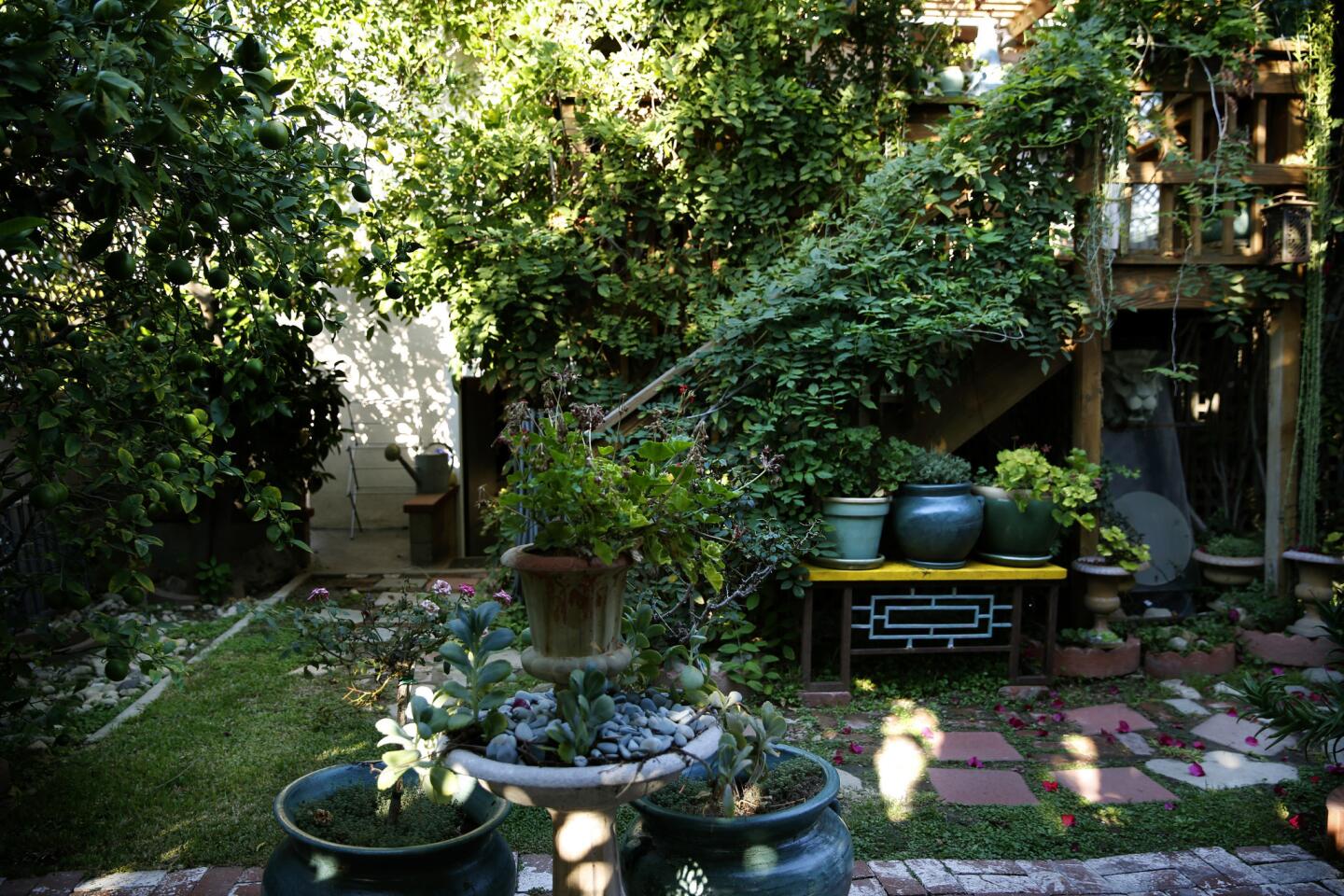
Wisteria trails up on the railing to the deck overlooking Iacovelli’s back garden, where he grows rosemary, lavender and herbs. The iron bench is from the Zen Garden set on the “Babylon 5” TV series.
(Liz O. Baylen / Los Angeles Times)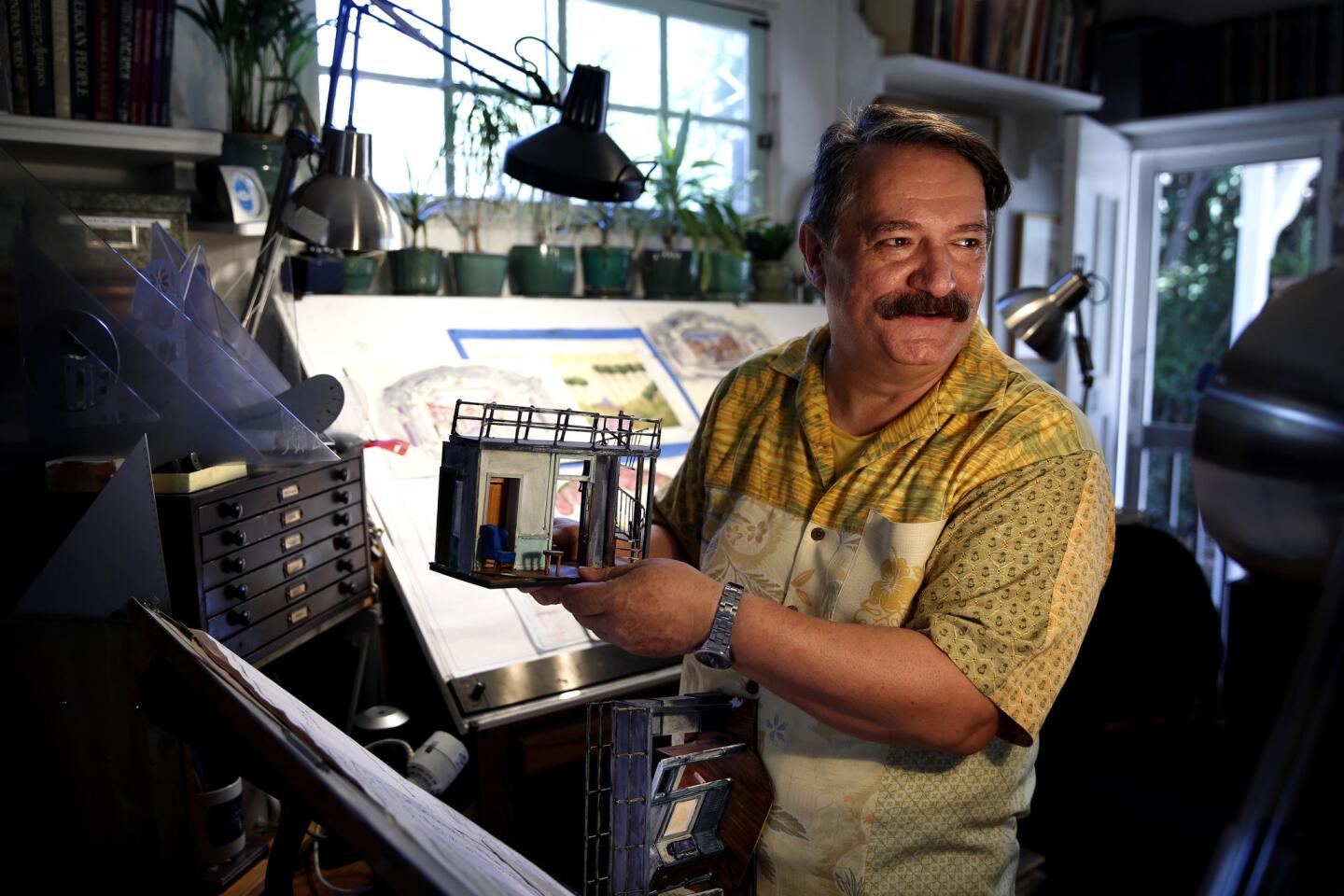
The drafting studio, formerly a garage, is where Iacovelli draws and makes models for stage sets. It now has Saltillo tile floors and a wall of windows where the garage door was. “It is wonderful to have my workspace separate from my house,” Iacovelli says.
(Liz O. Baylen / Los Angeles Times)Advertisement
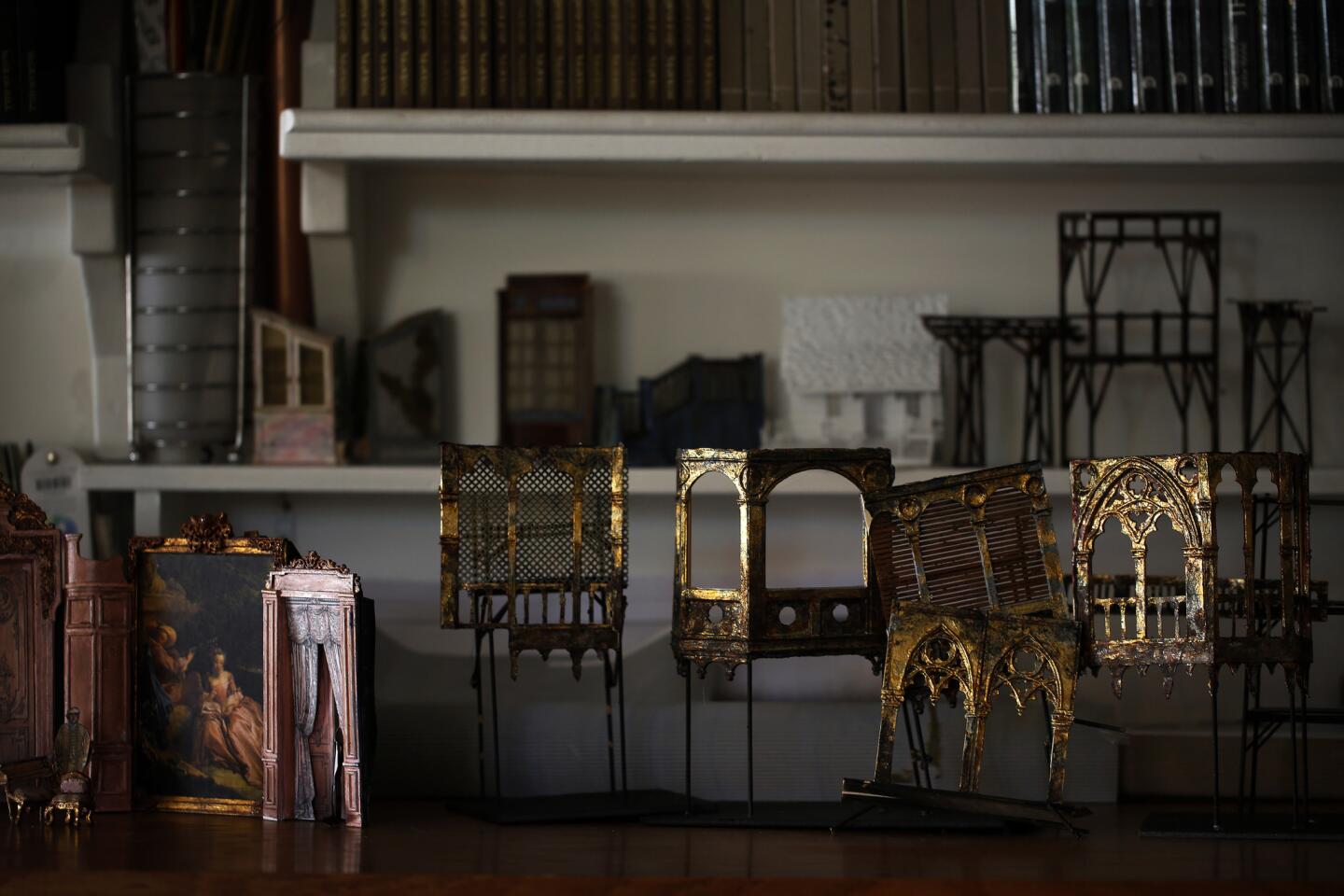
These maquettes are scale model pieces of scenery from “The Importance of Being Earnest,” Johnny Cash’s cabin for “Ring of Fire” and scaffolding for “Hamlet.” On the tabletop, left to right: Doors and a projection screen for “Amadeus” and Venetian wall pieces for “Volpone.”
(Liz O. Baylen / Los Angeles Times)


